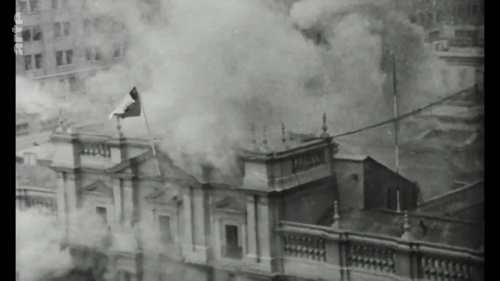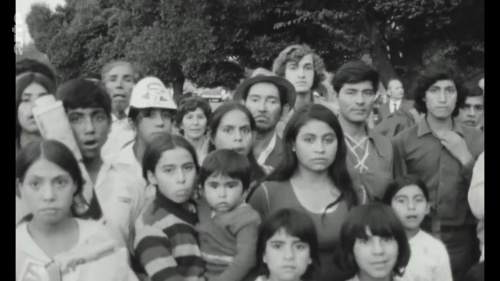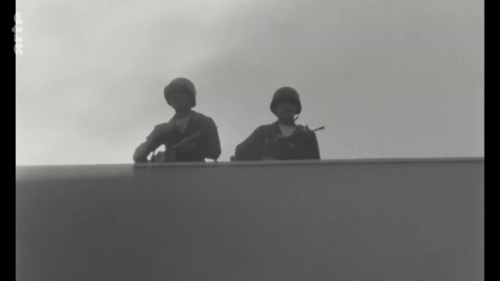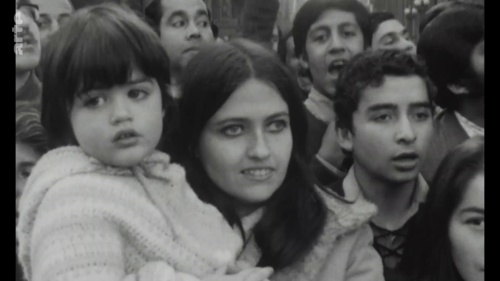|

Year: 1975-79
Country: Chile, Cuba
Director: Patricio Guzmán
Cast: Salvador Allende, Carlos Altamirano, Fernando Castillo, Luis Corvalán
IMBD: Link Link Link
Language : Spanish
Subtitles : French, English, Spanish, Italian, Polish

In October 1969, the Tricontinental magazine ran an article by two young Argentine filmmakers, Octavio Getino and Fernando Solanas, titled “Toward a Third Cinema.” The twenty-page piece would become something of a manifesto, articulating the theory behind a nascent cinematic movement, and inspiring an approach to political filmmaking that lives on over fifty years later.
“Toward a Third Cinema” posits that most films, up until that point, could be classified as one of two categories. First Cinema was the cinema of Hollywood — corporate-produced movies, designed above all to entertain (and thereby make a profit). Think Golden Age Hollywood musicals or Marvel movies. Though First Cinema demonstrated the potential of film as a medium to reach mass audiences, it had no radical intent.
Second Cinema, on the other hand, is more often auteur-driven and experimental, concerned primarily with artistic expression. In many ways, Second Cinema marks a political step forward from First, pushing the boundaries of the medium in pursuit of loftier goals than mere spectacle. But according to Getino and Solanas, its political potential nevertheless remained limited by the commercial imperative. At worst, Second Cinema could become navel-gazing and individualist. At best, it testified to the existence of injustice and the suffering of the working class, but it remained divorced from a sophisticated critique of the material relations that produce such suffering, and their alternatives.
Recognizing both the strengths and limits of these two forms, Getino and Solanas proposed a Third Cinema, explicitly concerned with using the power of film to educate and agitate the masses toward class struggle and national liberation. Seemingly influenced by the work of early Soviet cinema, the thought of philosopher-educator Paulo Freire, and, perhaps most of all, theorist-playwright Bertolt Brecht, Getino and Solanas decried how Argentina’s film industry was “set up to accept and justify dependence, the origin of all underdevelopment.” Instead, they urged the development of a cinema designed to advance its audience’s anti-imperialist class consciousness. As they put it:
The anti-imperialist struggle of the peoples of the Third World and of their equivalents inside the imperialist countries constitutes today the axis of the world revolution. Third cinema is, in our opinion, the cinema that recognises in that struggle the most gigantic cultural, scientific, and artistic manifestation of our time, the great possibility of constructing a liberated personality with each people as the starting point — in a word, the decolonisation of culture.
Getino and Solanas rejected a simplistic belief in the power of art or language to unilaterally change the world. Rather, they understood culture as just one site of contestation. Cultural production was one powerful tool with the potential to interact, dialectically, with material conditions to further the real struggle for Third World liberation.
In Political Film, scholar Mike Wayne identifies four key elements by which Third Cinema seeks to achieve these goals: historicity — the film situates itself in history, understood as “process, change, contradiction, and conflict”; politicization — the film explores “the process whereby people who have been oppressed and exploited become conscious of that condition and determine to do something about it”; critical commitment — while no artistic work is detached from ideology, Third Cinema embraces its critical perspective; and cultural specificity — the film grounds itself in its audience’s particular cultural context.
(Michael Galant)
Patricio Guzmán’s The Battle of Chile captures the class war that culminated in Salvador Allende's overthrow.
The Battle Of Chile: The Insurrection Of The Bourgeoisie (1975)
The Battle Of Chile: The Coup D'Etat (1976)
The Battle Of Chile: The Power Of The People (1979)

[ About file ]
Name: 01 The Battle Of Chile -The Insurrection Of The Bourgeoisie.Patricio Guzmán.1975.WEB-DL.mkv
Date: Thu, 14 Sep 2023 00:21:20 +0200
Size: 1,583,264,560 bytes (1509.918747 MiB)
[ Magic ]
File type: Matroska data
File type: EBML file, creator matroska
[ Generic infos ]
Duration: 01:36:20 (5779.934 s)
Container: matroska
Production date: Wed, 13 Sep 2023 11:35:27 +0200
Total tracks: 7
Track nr. 1: video (V_MPEG4/ISO/AVC) {eng}
Track nr. 2: audio (A_AAC) {spa}
Track nr. 3: subtitle (S_TEXT/WEBVTT) {fre}
Track nr. 4: subtitle (S_TEXT/WEBVTT) {eng}
Track nr. 5: subtitle (S_TEXT/WEBVTT) {spa}
Track nr. 6: subtitle (S_TEXT/WEBVTT) {ita}
Track nr. 7: subtitle (S_TEXT/WEBVTT) {pol}
Muxing library: libebml v1.4.2 + libmatroska v1.6.4
Writing application: mkvmerge v64.0.0 ('Willows') 64-bit
[ Relevant data ]
Resolution: 1920 x 1080
Width: multiple of 32
Height: multiple of 8
Average DRF: 16.866094
Standard deviation: 3.265016
Std. dev. weighted mean: 3.143178
[ Video track ]
Codec ID: V_MPEG4/ISO/AVC
Resolution: 1920 x 1080
Frame aspect ratio: 16:9 = 1.777778
Pixel aspect ratio: 1:1 = 1
Display aspect ratio: 16:9 = 1.777778
Framerate: 25 fps
Stream size: 1,488,969,611 bytes (1419.992076 MiB)
Duration (bs): 01:36:20 (5779.88 s)
Bitrate (bs): 2060.90038 kbps
Qf: 0.039755
[ Audio track ]
Codec ID: A_AAC
Sampling frequency: 44100 Hz
Channels: 2
Stream size: 92,153,141 bytes (87.884084 MiB)
Bitstream type (bs): AAC LC (Low Complexity)
Frames (bs): 248,921
Duration (bs): 01:36:20 (5779.934331 s)
Chunk-aligned (bs): Yes
Bitrate (bs): 127.549049 kbps VBR
Sampling frequency (bs): 44100 Hz
Mode (bs): 2: front-left, front-right
[ Video bitstream ]
Bitstream type: MPEG-4 Part 10
User data: x264 | core 164 r3095 baee400 | H.264/MPEG-4 AVC codec
User data: Copyleft 2003-2022 | http://www.videolan.org/x264.html | cabac=1
User data: ref=3 | deblock=1:0:0 | analyse=0x1:0x111 | me=hex | subme=8 | psy=1
User data: psy_rd=1.00:0.00 | mixed_ref=1 | me_range=16 | chroma_me=1
User data: trellis=2 | 8x8dct=0 | cqm=0 | deadzone=21,11 | fast_pskip=1
User data: chroma_qp_offset=-2 | threads=34 | lookahead_threads=5
User data: sliced_threads=0 | nr=0 | decimate=1 | interlaced=0
User data: bluray_compat=0 | constrained_intra=0 | bframes=3 | b_pyramid=2
User data: b_adapt=2 | b_bias=0 | direct=3 | weightb=1 | open_gop=0 | weightp=2
User data: keyint=100 | keyint_min=50 | scenecut=40 | intra_refresh=0
User data: rc_lookahead=50 | rc=abr | mbtree=1 | bitrate=2061 | ratetol=1.0
User data: qcomp=0.60 | qpmin=0 | qpmax=69 | qpstep=4 | vbv_maxrate=4122
User data: vbv_bufsize=8244 | nal_hrd=none | filler=0 | ip_ratio=1.40
User data: aq=1:1.00
SPS id: 0
Profile: Main@L4
Num ref frames: 4
Aspect ratio: Square pixels
Chroma format: YUV 4:2:0
PPS id: 0 (SPS: 0)
Entropy coding type: CABAC
Weighted prediction: P slices - explicit weighted prediction
Weighted bipred idc: B slices - implicit weighted prediction
8x8dct: No
Total frames: 144,497
Drop/delay frames: 0
Corrupt frames: 0
P-slices: 50605 ( 35.021 %) #######
B-slices: 90690 ( 62.763 %) #############
I-slices: 3202 ( 2.216 %)
SP-slices: 0 ( 0.000 %)
SI-slices: 0 ( 0.000 %)
[ DRF analysis ]
average DRF: 16.866094
standard deviation: 3.265016
max DRF: 31
DRF=1: 130 ( 0.090 %)
DRF=2: 24 ( 0.017 %)
DRF=3: 1 ( 0.001 %)
DRF=4: 3 ( 0.002 %)
DRF=5: 0 ( 0.000 %)
DRF=6: 1 ( 0.001 %)
DRF=7: 0 ( 0.000 %)
DRF=8: 4 ( 0.003 %)
DRF=9: 41 ( 0.028 %)
DRF=10: 293 ( 0.203 %)
DRF=11: 502 ( 0.347 %)
DRF=12: 1245 ( 0.862 %)
DRF=13: 4390 ( 3.038 %) #
DRF=14: 6572 ( 4.548 %) #
DRF=15: 9012 ( 6.237 %) #
DRF=16: 17253 ( 11.940 %) ##
DRF=17: 32449 ( 22.457 %) ####
DRF=18: 33910 ( 23.468 %) #####
DRF=19: 21030 ( 14.554 %) ###
DRF=20: 11588 ( 8.020 %) ##
DRF=21: 1810 ( 1.253 %)
DRF=22: 202 ( 0.140 %)
DRF=23: 281 ( 0.194 %)
DRF=24: 250 ( 0.173 %)
DRF=25: 106 ( 0.073 %)
DRF=26: 48 ( 0.033 %)
DRF=27: 13 ( 0.009 %)
DRF=28: 5 ( 0.003 %)
DRF=29: 0 ( 0.000 %)
DRF=30: 2 ( 0.001 %)
DRF=31: 3 ( 0.002 %)
DRF>31: 0 ( 0.000 %)
P-slices average DRF: 16.076475
P-slices std. deviation: 3.064437
P-slices max DRF: 31
B-slices average DRF: 17.445992
B-slices std. deviation: 3.198625
B-slices max DRF: 31
I-slices average DRF: 12.920987
I-slices std. deviation: 2.817198
I-slices max DRF: 22
This report was created by AVInaptic (01-11-2020) on 12-05-2024 04:17:34





|

